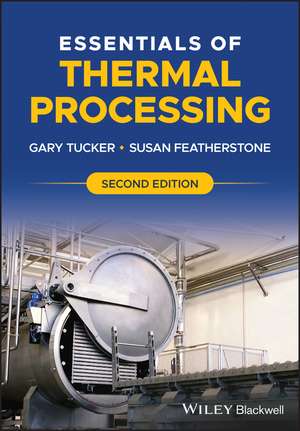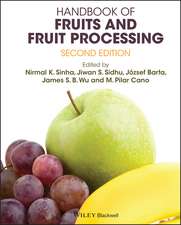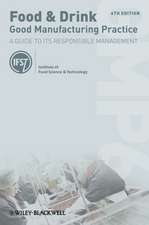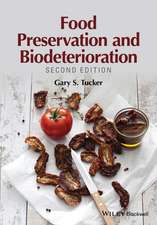Essentials of Thermal Processing, Second Edition
Autor G Tuckeren Limba Engleză Hardback – 2 iun 2021
Preț: 1169.85 lei
Preț vechi: 1285.55 lei
-9% Nou
Puncte Express: 1755
Preț estimativ în valută:
223.85€ • 234.20$ • 185.95£
223.85€ • 234.20$ • 185.95£
Carte tipărită la comandă
Livrare economică 02-16 aprilie
Preluare comenzi: 021 569.72.76
Specificații
ISBN-13: 9781119470373
ISBN-10: 1119470374
Pagini: 400
Dimensiuni: 174 x 255 x 24 mm
Greutate: 0.83 kg
Ediția:2nd Edition
Editura: Wiley
Locul publicării:Chichester, United Kingdom
ISBN-10: 1119470374
Pagini: 400
Dimensiuni: 174 x 255 x 24 mm
Greutate: 0.83 kg
Ediția:2nd Edition
Editura: Wiley
Locul publicării:Chichester, United Kingdom
Notă biografică
Gary Tucker, Campden BRI in the United Kingdom. Susan Featherstone is a Director at Safe Food Consulting in South Africa.
Cuprins
Preface
Glossary of Terms
1 History of Thermal Processing
1.1 A brief history of the science and technology of thermal processing
1.2 Food Microbiology as a Science
1.3 Packaging for Heat Preserved Foods
1.3.1 Convenience - the can opener is invented
1.3.2 Other forms of packing for "canned foods"
1.4 Developments in Cannery Equipment
1.5 Food Safety
2 Microbiology of Heat Preserved Foods
2.1 Food microbiology
2.1.1 Fungi
2.1.1.1 Moulds
2.1.1.2 Yeasts
2.1.2 Bacteria
2.1.2.1 Growth and reproduction of bacteria
2.2 Factors that affect the growth of microorganisms
2.2.1 pH
2.2.2 Moisture
2.2.3 Nutrients
2.2.4 Oxidation-reduction potential
2.2.5 Antimicrobial resistance
2.2.6 Biological structures
2.2.7 Relative humidity
2.2.8 Oxygen content/concentration of gases in the environment
2.2.9 Temperature
2.3 Description of some microorganisms of importance to thermal processing
2.3.1 Moulds
2.3.2 Yeasts
2.3.3 Bacteria
2.2.3.1 Thermophiles
2.3.3.2 Mesophiles - spore-forming bacteria
2.3.3.3 Mesophiles - non-spore forming pathogenic and spoilage bacteria
2.3.3.4 Psychrophiles
2.4 Risk of leaker spoilage from damaged or compromised packaging
2.5 A guideline for identifying spoilage in canned foods
3 Hurdles to Microbial Growth
3.1 Control of the microorganism loading
3.2 Use of restrictive pH levels
3.3 Anaerobic environment or modified atmosphere environment
3.4 Low temperatures
3.5 Dehydration or low water activity
3.6 Chemical preservation
3.6.1 Organic acids
3.6.2 Sulphites and nitrites
3.6.3 Antibiotics
3.6.4 Antioxidants
3.7 Irradiation
3.8 Combination Treatments
4 Low Acid Canned Foods
4.1 Production of a thermally processed food
4.2 F03 sterilisation processes
4.3 Commercial sterilisation
4.4 Microorganism death kinetics
4.5 Log reductions
5 Acid and Other Pasteurized Products
5.1 Background
5.1.1 Naturally acid foods
5.2 Pasteurisation
5.2.1 Considerations when designing a safe pasteurisation process
5.2.2 Calculation of pasteurisation values
5.3 Inhibitory factors to microorganism growth
5.4 P-value guidelines
5.4.1 High acid: pH
5.4.2 Acid: pH 3.5-4.0
5.4.3 Acid: pH 4.0-4.2
5.4.4 Medium acid: pH 4.2-4.6
5.5 Guidelines and General Recommendations
5.5.1 Guidelines to critical factors in thermal processing of acid foods
5.6 Thermal processing of fruit
5.3.1 Packaging selection
5.3.2 Oxidation reactions inside an internally plain can of acid fruit
5.3.3 Pigments that discolour in internally plain cans
5.7 Thermal processing of products with low water activity
5.7.1 Jam and high sugar preserves
5.7.2 Canned cake and sponge pudding
5.8 Thermal processing of cured meats
6 Acidified Foods
6.1 Background
6.2 Acidity measurement using pH
6.2.1 The history of pH
6.2.2 The chemistry of pH
6.2.3 Measurement of pH
6.2.3.1 Potentiometric method
6.2.3.2 Colorimetric measurement
6.2.4 Equilibrium pH
6.3 Acidification of foods
6.4 Processing acidified foods
6.5 Design of pasteurisation processes
6.5.1 Medium acid range: pH 4.2-4.6
6.5.2 Acid range: pH 3.5-4.2
6.5.3 High acid range: pH below 3.5
6.6 Hot fill and hold processing
6.7 Critical control points in the production of acidified foods
6.7.1 Ingredients
6.7.2 Heat processing
6.7.3 Post process equilibrated pH
6.7.4 Container integrity
6.7.5 pH during product shelf-life
7 Heat Preserved Chilled Foods
7.1 Understanding microorganism behaviour
7.1.1 Pathogenic microorganisms relevant to chilled foods
7.1.1.1 Clostridium botulinum
7.1.1.2 Bacillus cereus
7.1.2 Microorganisms likely to be found in chilled foods
7.2 Methods of manufacture
7.2.1 Thermal process step applied prior to packaging
7.2.1.1 Low care-high care factories
7.2.2 Thermal process step applied after packaging
7.2.2.1 Caution with latent heat for frozen protein
8 Processing Systems
8.1 In-pack processing: Retort systems
8.1.1 Condensing steam retorts
8.1.2 Crateless retorts
8.1.3 Water immersion retorts
8.1.4 Water spray and cascade
8.1.5 Steam / air retorts
8.1.6 Shaka retorts
8.1.7 Reel & spiral retorts
8.1.8 Hydrostatic retorts
8.2 In-line processing: Heat exchangers
8.2.1 Flow behaviour
8.2.2 Choice of heat exchanger
8.2.3 Maximising product recovery
7.3 New thermal technologies
9 Cook Values and Optimisation of Thermal Processes
9.1 Mathematical analysis of cooking
9.1.1 Cooking equations and kinetic data
9.1.2 Competition between sterilisation and cooking
9.1.3 Optimisation of temperature / time in processing
9.2 Setting process targets
9.2.1 How to select processing conditions without excess quality damage
10 Process Validation: Temperature and Heat Distribution
10.1 Temperature Distribution
10.1.1 Temperature measurement systems
10.2 Heat Distribution
10.2.1 Modes of heat transfer
10.2.1.1 Radiation
10.2.1.2 Conduction
10.2.1.3 Convection
10.2.1.4 Broken heating or mixed heating
10.3 Heat distribution testing
10.3.1 Conducting a HD test
11 Process Validation: Heat Penetration and Process Calculations
11.1 Setting the target process value
11.2 Selecting the conditions for the HP study
11.3 Locating the product cold point
11.4 Process establishment methods
11.4.1 Log reduction methods for HP testing
11.4.1.1 Microbiological spore methods
11.4.1.2 Biochemical systems
11.5 Process calculation methods
11.5.1 General method
11.5.2 Ball method
11.5.3 Numerical methods
11.5.3 Continuous flow with particulates
12 Cooling and Water Treatment
12.1 Chlorine
12.1.1 Chlorine demand and residual chlorine
12.1.2 Using chlorine
12.2 Chlorine dioxide
12.3 Bromine
12.4 Ozone
12.5 Ultraviolet light
12.6 Membrane filtration
13 Handling Processing Deviations
13.1 What constitutes a process deviation
13.2 What can go wrong
13.3 Actions required
13.3.1 TPA actions
13.3.2 Process deviation analysis for broken heating products
13.3.2 Reprocessing
14 Packaging Options for Heat Preserved Foods
14.1 Metal containers
14.1.1 Tin plate
14.1.2 Tin free steel (TFS or ECCS)
14.1.3 Aluminium
14.1.4 Protective coatings (lacquers)
14.1.4.1 Vinyl lacquers 4
14.1.4.2 Organosol lacquers
14.1.4.3 Epoxy-phenolic lacquer
14.1.4.4 Polyester lacquer
14.1.4.5 Acrylic Lacquers
14.1.4.6 Side stripe lacquers to cover the weld
14.1.5 Internally plain (unlacquered) cans
14.1.6 External covering
14.2 Can construction and handling
14.2.1 Product specification
14.2.2 Storage and handling of empty unused cans and ends
14.2.3 Cleaning of empty unused cans
14.2.4 Double seam formation and inspection procedures
14.2.5 Washing of filled cans
14.2.6 Processing of cans
14.2.7 Cooling of cans
14.2.7.1 Corrosion prevention
14.2.8 Secondary packaging
14.3 Glass
1.3.1 Glass manufacture
14.3.2 Closures for sealing glass food containers
14.3.3 Sealing mechanisms
14.3.4 Inspection procedures
14.3.5 Packing and processing
14.3.5.1 Inspection and preparation of containers
14.3.5.2 Filling
14.3.5.3 Capping
14.3.5.4 Atmospheric processing
14.3.5.5 Pressure processing
14.3.5.6 Cooling
14.4 Plastics, flexibles and laminates
14.4.1 Advantages of retortable plastics
14.4.2 Disadvantages of retortable plastics
14.4.3 Polymers used for retortable packaging
14.4.3.1 Polypropylene (PP)
14.4.3.2 Polyethylene terephthalate (PET)
14.4.3.3 Ethylvinylalcohol (EVOH)
14.4.3.4 Polyvinylidene chloride (PVDC)
14.4.3.5 Polyamide (PA)
14.4.3.6 Aluminium
14.4.3.7 Glass-coated barrier films
14.4.4 Types of packages used for thermally processed foods
14.4.4.1 Retort pouches
14.4.4.2 Plastic cans and pots
14.4.4.3 Retortable composite carton
14.4.5 Processing considerations - control of headspace
15 Incubation Testing
15.1 Purpose of incubation tests
15.2 Causes of spoilage
15.2.1 Leaker spoilage
15.2.2 Under-processing
15.2.3 Thermophilic spoilage
15.3 Descriptive terms for canned food spoilage
15.4 Methods for incubation testing
15.4.1 Sample size
15.4.2 Temperatures and times for incubation
15.4.2.1 Thermophilic organisms
15.4.2.2 Mesophilic organisms
15.4.3 Post incubation inspection of containers
15.5 Biotesting
16 Critical Factors in Thermal Processing
16.1 Background
16.2 Key aspects of hygiene control systems for food processing (from Codex Alimentarius)
16.3 Identifying critical control points in thermal processing
16.3.1 Microbial load or bio-burden
16.3.2 pH of the product
16.3.3 Water activity (aw)
16.3.4 Consistency
16.3.5 Presence, concentration and types of preservatives
16.3.6 Rehydration
16.3.7 Blanching
16.3.8 Size and style of in-going ingredients
16.3.9 Container, packing and filling considerations
16.3.9.1 Headspace
16.3.9.2 Container vacuum and exhausting of containers
16.3.9.3 Container size and geometry
16.3.9.4 Initial temperature of product
16.3.10 Process related critical factors
16.3.10.1 Processing method
16.3.10.2 Processing medium
16.3.10.3 Type and characteristics of heat processing system
16.3.10.4 Processing temperature
16.3.10.5 Processing time
16.3.10.6 Processing at high altitudes
17 Environmental Aspects of Thermal Processing
17.1 Lifecycle Assessment (LCA)
17.1.1 Impact categories
17.1.1.1 Global warming potential (GWP)
17.1.1.2 Pesticide use / ecotoxicity
17.1.1.3 Abiotic resource use
17.1.1.4 Acidification potential
17.1.1.5 Eutrophication potential
17.1.1.6 Land use
17.1.1.7 Water use
17.2 Greenhouse gas emissions
17.2.1 Case study: Bottled apple juice
17.2.1.1 Raw materials (0.407 kg CO2e/PU)
17.2.1.2 Manufacture (0.061 kg CO2e/PU)
17.2.1.3 Transportation (0.057 kg CO2e/PU)
17.2.1.4 Waste (0 kg CO2e/PU)
17.2.1.5 Overall carbon footprint (0.525 kg CO2e/PU)
17.2.1.6 GHG emissions for other food products
Index
















